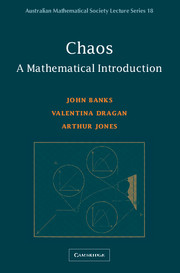Book contents
- Frontmatter
- Contents
- Preface
- 1 Making predictions
- 2 Mappings and orbits
- 3 Periodic orbits
- 4 Asymptotic orbits I: linear and affine mappings
- 5 Asymptotic orbits II: differentiable mappings
- 6 Families of mappings and bifurcations
- 7 Graphical composition, wiggly iterates and zeroes
- 8 Sensitive dependence
- 9 Ingredients of chaos
- 10 Schwarzian derivatives and ‘woggles’
- 11 Changing coordinates
- 12 Conjugacy
- 13 Wiggly iterates, Cantor sets and chaos
- Index
12 - Conjugacy
Published online by Cambridge University Press: 05 June 2012
- Frontmatter
- Contents
- Preface
- 1 Making predictions
- 2 Mappings and orbits
- 3 Periodic orbits
- 4 Asymptotic orbits I: linear and affine mappings
- 5 Asymptotic orbits II: differentiable mappings
- 6 Families of mappings and bifurcations
- 7 Graphical composition, wiggly iterates and zeroes
- 8 Sensitive dependence
- 9 Ingredients of chaos
- 10 Schwarzian derivatives and ‘woggles’
- 11 Changing coordinates
- 12 Conjugacy
- 13 Wiggly iterates, Cantor sets and chaos
- Index
Summary
In the previous chapter we described some simple changes of coordinates on the line in terms of invertible affine mappings. These mappings are called transition mappings from one coordinate system to the other.
In this chapter we consider changes of coordinates in which the transition mappings are not necessarily affine, but are still invertible and continuous.
Topological conjugacy (or just conjugacy for short) is the relationship which exists between two mappings when one is obtained from the other by a change of coordinates. We shall prove that when two mappings are in this relationship, they have similar dynamics; in particular when one is chaotic so is the other.
Unfortunately, there is no systematic method for showing conjugacy between a given pair of mappings and it is usually difficult to prove it. We can prove, however, that the tent mapping T4 and the logistic mapping Q4 are conjugate. More generally, we prove that all maps with wiggly iterates are conjugate to the tent map.
DEFINITION AND EXAMPLES
This section is about changes of coordinates between two mappings which are no longer assumed to be affine. A transition mapping for any change of coordinates needs to be both continuous and invertible. Continuity ensures that points which are close together in one coordinate system will also be close in the other coordinate system. Invertibility ensures that we can ‘undo’ the change of coordinate.
- Type
- Chapter
- Information
- Chaos: A Mathematical Introduction , pp. 217 - 254Publisher: Cambridge University PressPrint publication year: 2003

